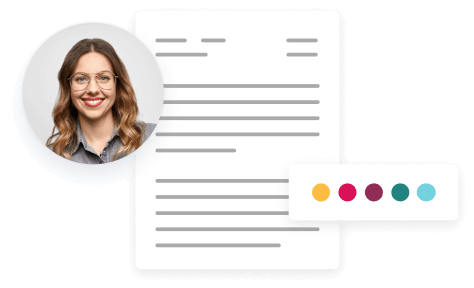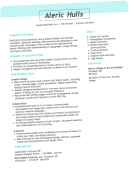 Use This Template
Use This TemplateHow To Choose A Basic Resume Template
With all the templates to choose from, it can be hard to pick a basic resume. However, with a few simple tips to keep in mind, you can be sure you pick the resume that is right for you.
-
Choose a format. Format makes all the difference with resumes. There are three main types of resume formats, they are:
Chronological. With a focus on job experience, this format lists your most current work experience, followed by the previous experiences. It is very popular with recruiters and employers because it is easy to read and underscores the specifics about qualifications.
Functional. This resume format focuses on job skills. If you don’t have a lot of experience, are switching careers, or have many gaps in your resume, a functional resume can help you highlight your transferable skills.
Combination. As the name suggests, this resume format combines the formats of chronological and functional resumes.
Know your audience. Every industry has a different set of standards, so you will want to make sure your template appropriately matches expectations.
Complement your qualifications. A template should uplift your strengths and bring them to the attention of the reader. If you have extensive relevant experience, pick a resume that gives you plenty of space to showcase your abilities. If you have limited experience, or are changing industries, pick a resume that provides space for transferable skills.
Ask for feedback. The great thing about having access to all of these free resume templates means that you can pick several different types! Ask people who are in similar positions to take a look at your choices to see what they think.
Basic Resume Template Pros and Cons
Universal appeal: Basic resumes typically have a very classic and traditional tone. While they may have touches of color to add emphasis, in general they are designed to have universal appeal and can be used in a variety of industries.
Easy to read: A basic resume clearly communicates your job history, work experience, accomplishments and education — in the order you desire. We have free resume templates in the top three resume formats — chronological, functional and combination, to allow you to focus the reader’s attention where you desire.
Easy to make: An easy resume layout means you won’t be spending hours trying to nail down the perfect resume.
ATS-friendly: The clean layout and simple design of our basic resumes is easy for applicant tracking systems to read. This means you can be sure to avoid unnecessary errors that could filter you out of consideration.
Can fail to impress: A basic resume is the ideal choice for most conventional jobs, but if you’re pursuing a job in a creative industry, it doesn’t indicate your personal or professional style. Your job search would benefit more from using a creative or portfolio resume.
Makes errors noticeable: The simple design of a basic resume means there’s nothing to distract the hiring manager from the document’s content. A basic resume makes the error more visible and can negatively impact your job search.
Save Time And Use Hloom’s Resume Builder
Want to create your resume now but still need help? Then save yourself the stress and try our Resume Builder. We feature a variety of templates that auto-format your information. Just fill in a brief form and your resume is done in minutes.
Helping Job Seekers Like You
Basic Resume FAQ
A basic resume follows the standard resume structure. This includes:
- Contact information: A hiring manager needs to quickly locate your name and contact information for any potential follow-up.
- Professional summary: Also known as a summary statement or professional profile, this two to three sentence summary introduces your key strengths and what value you bring as a job candidate.
- Work history: There are a few ways to structure this information based on the resume format you use. The most common method is to highlight your past job title and period of employment, name and location of your former employer, and list three accomplishments or responsibilities for each job.
- Skills: Normally you will want to share six to eight soft and hard skills relevant to the job description. We compiled a list of hiring managers’ most commonly requested skills to consider adding to your resume.
- Education: This includes a combination of formal degrees, job-training seminars and specialized certifications related to your work.
You can learn more about how to write each of these resume sections by reading our resume-writing guide.
A basic resume template can be used for any profession. Still, the following industries are best for a basic resume template because the minimal design focuses on your technical skills and professional accomplishments:
- Banking
- Finance
- Administrative
- Accounting
- Research
- Computer software
- Health care support
- Food service
- Retail
- Nursing
- Statistics
- Law
- Safety and security
- Inventory management
A basic resume should look clean, standard and professional. The document design and construction follows the same conventional layout as academic assignments.
A basic resume may include some, in not all, of the following design elements:
- Standard 1-inch margins
- Standard 1.5 or double line-spacing
- Conventional fonts (Times New Roman or Arial)
- Size 10-12 font on the main body
- Size 14-16 font for section headers
- Little to no added pops of color
- Clear space or borders between resume sections
- Vertical lines to highlight sections
- Columns, tabs and plenty of white space to make it easy to read
- No photos and graphics, but some include simple skill meters
The basic resume style in a chronological format is the easiest to read and write. It is easy for the reader to follow because your work history logically flows from the most recent to the next experience. It is also the easiest to write because the minimal design can allow you to have more control over what you include.
The three most common resume styles are chronological, functional, and combination.
- Chronological resumes: Here your job history is the primary focus. It is especially effective for those with a steady work history with little to no work gaps. Chronological resumes are also the most familiar layout and therefore are preferred by recruiters and employers.
- Functional resumes: If you want to highlight your professional achievements, abilities and work-related skills, you’ll benefit from a functional resume. This format is perfect for you if you took a work gap to focus on personal responsibilities such as family, education or wellness.
- Combination resumes: If you’d like to focus on both your skills and formal work history, use the combination format. The skills get priority without stripping information from your previous employment. This is perfect if you have consistent work history, but have worked less than 10 years.
Citations
- Olvia Crosby, “Resume, Applications, and Cover Letters,” Occupational Outlook Quarterly, 2009, https://www.bls.gov/careeroutlook/2009/summer/art03.pdfM.










